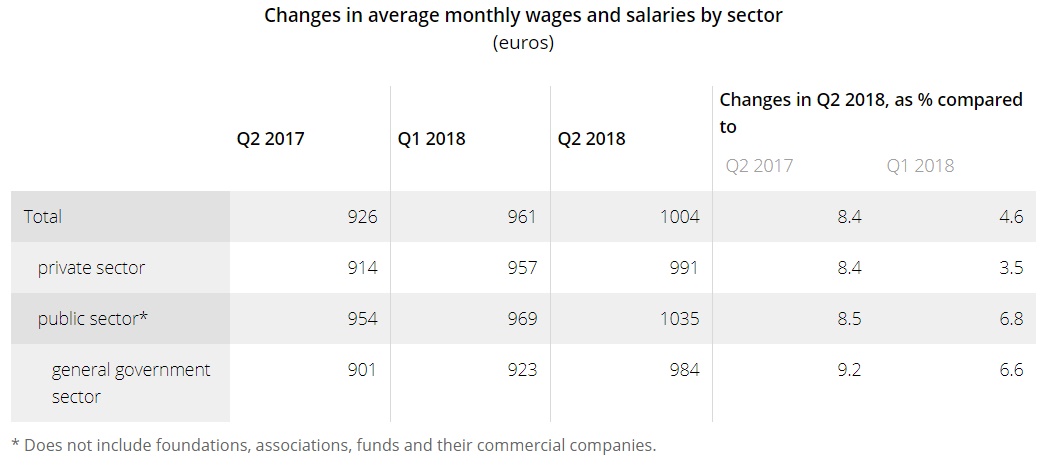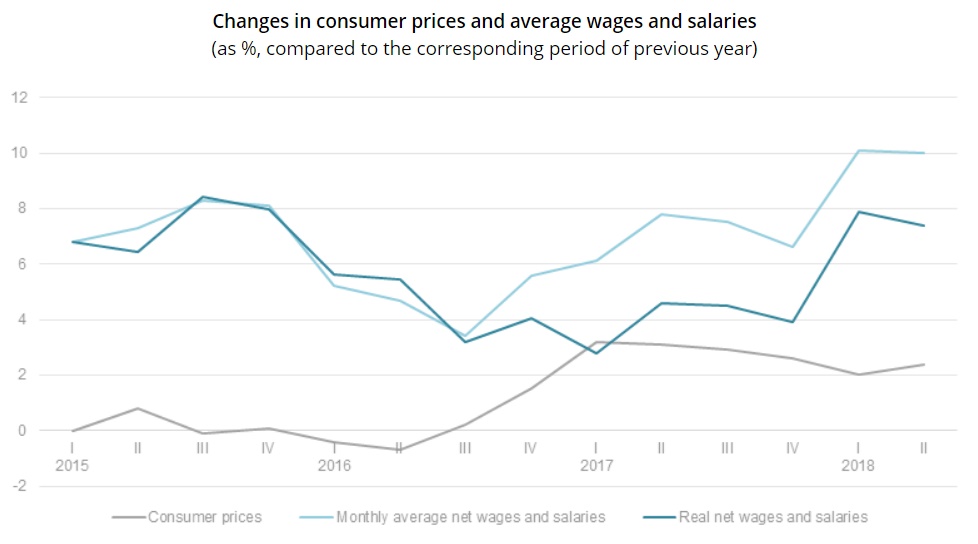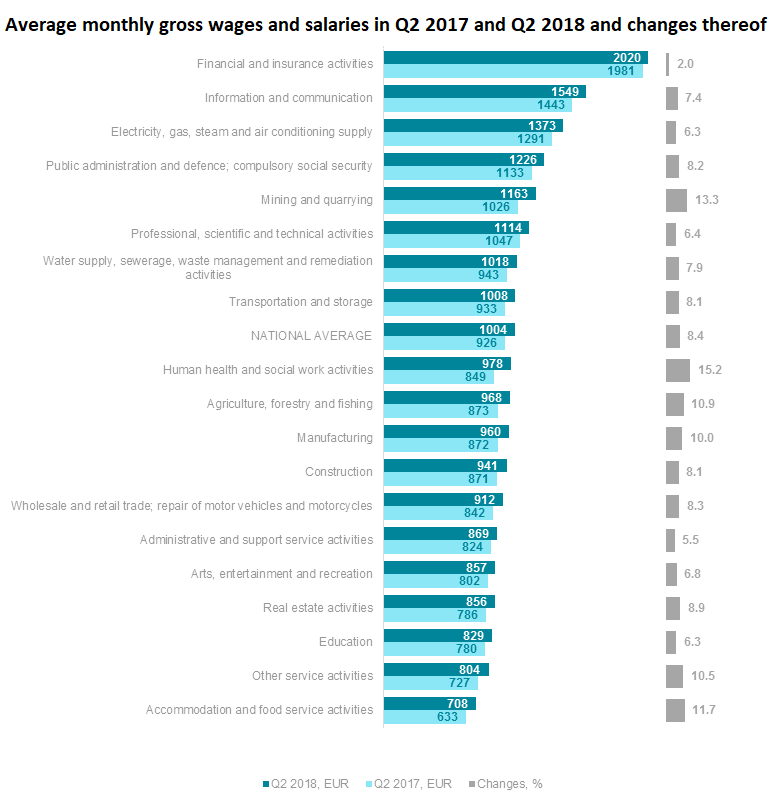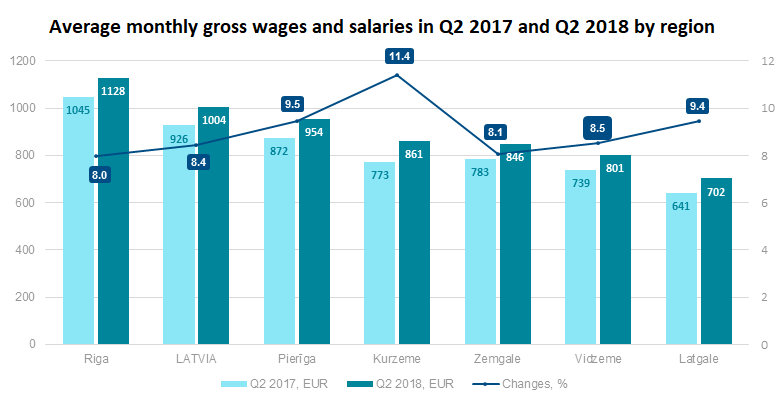Analytics, Estonia, EU – Baltic States, Good for Business, Latvia, Lithuania, Statistics, Wages
International Internet Magazine. Baltic States news & analytics
Thursday, 25.12.2025, 12:00
Average earnings have exceeded 1000 euros in Latvia
 Print version
Print versionOver the
year, the rise in wages and salaries was similar in both private and public
sector
Annual rise of earnings was almost equal in both sectors – 8.4% and 8.5%,
respectively. The average gross wages and salaries constituted 991 euros
in private sector and 1035 euros in public sector, while in general government
sector, which includes central and local government institutions, as well as
enterprises controlled and financed by the central and local government, the
average wages and salaries rose to 984 euros or by 9.2%.

Net
wages and salaries constitute 743 euros
In the 2nd quarter of 2018, the average net wages and
salaries (calculated based on the labour taxes applicable at workplace)
constituted 743 euros. Compared to the previous quarter, net wages and salaries
went up by 4.4%. Over the year, the earnings increased by 10.0%, showing
1.6 percentage points higher rise than that of wages and salaries before
taxes.
Considering annual consumer price growth of 2.4%, the real increase in
net wages and salaries comprised 7.4%.

Sharpest
wage rise recorded in human health and social care activities
Changes in the average wages and salaries are influenced not only by the
rise of employee remuneration, but also structural changes on the labour market
– enterprises that had started and stopped their business during the year,
changes in the number of employees and workloads in various economic sectors,
as well as state administrative measures in the fight against the shadow
economy. The effects caused by the mentioned factors in general may be seen in
the changes in the wage and salary fund and number of full-time employees,
which are used in the average wage calculations.
In the 2nd quarter of 2018, compared to the 2nd quarter
of 2017, gross wage and salary fund increased by 9.1% or 188.5 mln euros,
while the number of salaried workers, recalculated into full-time units, grew
only by 0.6% or 4.4 thousand.
In the 2nd quarter of the year, the sharpest rise in wages
and salaries was recorded in human health and social work activities (of 15.2%,
with faster growth in human health activities), mining and quarrying (13.3%),
accommodation and food service activities (11.7%, with the sharper rise in
catering), agriculture, forestry and fishing (10.9%, with faster growth in crop
and animal production, hunting and related service activities, as well as
forestry and logging), other service activities (10.5%, with sharper rise in
washing and (dry-)cleaning; hairdressing and other beauty treatment; funeral
and related activities; and other personal service activities), and
manufacturing (10.0%).
Highest
earnings in financial and insurance activities and lowest in accommodation and
food service activities
In the 2nd quarter of 2018, the highest average wages and
salaries for full-time work were registered in financial and insurance
activities, information and communication, energy, public administration,
mining and quarrying, professional, scientific and technical activities, water
supply; sewerage, waste management and remediation activities, as well as
transportation and storage. In other sectors, the average wages and salaries
before taxes were below the national average.
The lowest wages and salaries, in turn, were observed in accommodation
and food service activities, other service activities (that include activities
of public and other organisations, repair of computers and personal and
household goods, washing and (dry-)cleaning, hairdressing and other beauty
treatment, funeral and related activities), education, real estate activities,
as well as arts, entertainment and recreation.

Lowest
earnings still recorded in Latgale
Compared to the 2nd quarter of 2017, in the 2nd quarter of 2018 regional breakdown shows the sharpest rise in the average monthly gross wages and salaries in Kurzeme (of 11.4%), Pierīga (9.5%), and Latgale region (9.4%). The annual rise in Riga, having the highest wages and salaries (1128 euros), was the smallest among regions. Smaller increase was registered also in Zemgale (8.1% annually) and Vidzeme regions (8.5%).
The lowest average gross wages and salaries for full-time work still were
observed in Latgale region – 702 euros, constituting 70% of the national
average.

Estonia
has higher earnings, while Lithuania sharper rise thereof
In the Baltic states, the highest monthly average gross wages and
salaries in the 2nd quarter of 2018 were recorded in Estonia – 1321
euros, followed by Latvia with 1004 euros and Lithuania with 927 euros.
Compared to the 2nd quarter of the previous year, the average
wages and salaries have increased in all Baltic states. The sharpest rise was
recorded in Lithuania (of 10.5%), followed by Latvia (8.4%) and Estonia (6.4%).








 «The Baltic Course» Is Sold and Stays in Business!
«The Baltic Course» Is Sold and Stays in Business!

